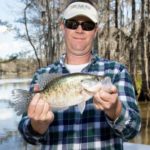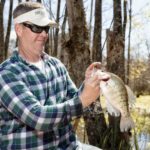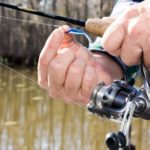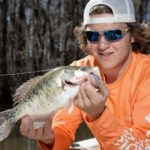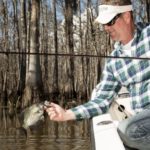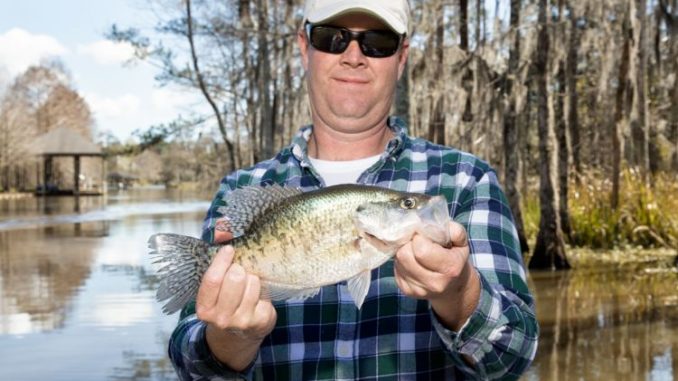
If you’re in the mood for some crappie, the West Pearl River is filled with the tasty fish. All you need to be successful is an understanding of how the fish react to current.
When I was 10 years old, my dad, brother and I were hanging out in the Bogue Chitto River behind our house one day.
It was the middle of summer, and the welcomed relief of the cool water washed away the memory of having to haul hay the day before.
I was leaning against a log, letting the water run through and around my legs. Then my feet slipped out from under me and I went under.
Grabbing desperately for the log, I felt like I was going to succumb to the strong current while my dad and brother — unaware that I was about to drown — skipped smooth, flat rocks on the river.
Through some quirk of fate, I was able to maneuver right behind the log where the current wasn’t as strong. It was just about then that I remembered the Bogue Chitto is a very shallow river.
“Stand up!” my dad hollered upon noticing me flailing away aimlessly as my life passed before my eyes. “It’s only knee deep.”
You could say I got a firsthand lesson on how fish survive in swift current.
Fish that live in rivers really only have two options.
One, they can expend all their energy working to battle the current out in the open. Two, they can get behind something that blocks the current and let the river do all the work.
Not too long ago, local Slidell angler Brian Baldwin invited me to see how he deals with crappie, aka white perch, in the West Pearl River.
Baldwin, who runs swamp boats for Honey Island Swamp Tours out of Crawford’s Landing, has plenty experience dealing with white perch in the current.
I met him and fellow local angler Steele Sessions at Crawford’s Landing, and we immediately headed south to a narrow slough Baldwin called Doubloon Bayou.
The water out in the main river was flowing swiftly, but it slowed to hardly anything as we entered the cut.
“White perch like to get in spots like this because they’re lazy,” Baldwin said. “And back here where we’ve got very little water movement, they’ll still find spots behind obstructions in the water where they can hang out and not have to fight the current.”
During April, Baldwin expects spots like Doubloon Bayou, Devil’s Elbow, Gum Bayou and the Oyster Factory Canal to be perfect spots to find white perch on the West Pearl.
“They’re all very close together on the west side of the river,” Baldwin said, as he cast a Blue Horizon Matrix Mini about 2 feet under a small cork. “All of them are going to have some water moving through them — the Oyster Factory especially.
“It’s more tidal influenced since it’s farther south than the others.”
Because he expects to find white perch in a post-spawn phase, Baldwin motors to the backs of these cuts and bayous, and fishes his way out.
“They kind of move up and back with the rise and fall of the river,” he explained. “April is generally a high-water month, so they’re probably going to be as far back as they can go. As the water rises and falls with the tide, though, they’ll either move out in flooded cover where nobody can get to them or they’re going to stack up on the outer edges of the trees where they become easy pickings.”
Baldwin, Sessions and I continued to fish the edges of the cover as we moved farther back into Doubloon Bayou. It didn’t take long for me to notice that both of them were popping their corks much like they would for speckled trout.
“We want to draw their attention,” Sessions said. “Sounds like a little shad when it hits the water. They make the same kind of flicking sound, and when you pop the cork like that I believe you’re imitating the same thing.
“It’s just as effective for white perch as it is for speckled trout and redfish.”
At that moment, our corks had not gone down a single time, so Baldwin decided it was time to move farther back in the bayou.
“We’ve going togive this just another minute or two,” he said. “We’re going to get out of this one. You can’t beg them to bite. You got to stick and move. If they aren’t there, don’t sit there and force the issue.
“They’re generally pretty willing biters, so if they’re not biting here they’re biting somewhere else. We’ve just got to find where.”
As we motored deeper into Doubloon Bayou, Baldwin pointed out some little pockets of black water pooled up back in the flooded woods.
The black water is what Baldwin called settled water. In other words, because it’s back up in the woods it has a chance for the silt to fall out of it.
“It just sits there, and the tannic acid from the decomposing leaves turns it almost the color of a glass of sweet tea or Coca-Cola,” he said. “When the river is falling or the tide is going out, that black water will pull out into the turbid water in the cut or bayou that isn’t settled.
“You’ll actually see it pulling out and mixing with the dirty water. That’s a great place to find white perch when you’ve got some current.”
Although we didn’t find any of the black water pulling out of the woods during our trip, Baldwin and Sessions were able to take advantage of the slowly moving water to eventually find white perch holding tight to the bases of the tupelo trees lining both sides of Doubloon Bayou.
Our primary pattern was one Baldwin predicted would hold true through April and on into the summer: The fish were suspended about 2 feet deep in 4 feet of water.
“No matter where I’m fishing for white perch,” Baldwin said, “I like to start fishing half the depth of the water as a good starting point. Say it’s 8 feet deep: In that case I’ll start at 4 feet. If it’s 6, I’ll start at 3.
“Then I’ll adjust up or down a little bit at a time until I get bit.”
Generally speaking, Baldwin finds the West Pearl’s white perch to be a little bit deeper when the sun is high, and higher in the water column during overcast conditions.
“But during the day, you can sometimes find them suspended under any floating grass mats that are being pushed around in the current,” he said. “Then you have to go in there and get them with a jig pole, and you may not get out every one that bites, but that’s a good way to fish in the current.”
When he’s fishing under a cork, he uses heavier jigheads in current because he wants his jig to hang as straight as possible under it. This is when he switches to a 1/8-ounce head to pin it down there and hold it in the current.
“The more your jig washes to the side the more trouble you’ll have with it snagging, and you’ll lose a lot of jigs,” Baldwin said. “Even if you’re fishing tight-line under a jig pole, you’ll want to keep it hanging straight up and down.
“The more you start jerking it around the more of a mess you’ll wind up with.”
We were fishing with the blue horizon Matrix Mini, and Baldwin explained why he liked that lure in current.
His primary reason for fishing it in current was the paddle-style tail that flutters when it’s being held still.
Although the ebb and flow of the tide means the white perch bite could turn on and off like a switch, one of the key things to keep an eye on if you’re planning on fishing the West Pearl is the Pearl River at Pearl River gauge.
“You’re going to get the best black water falling out of the woods when it’s dropping from 12 to 10 feet,” Baldwin said. “If you’re going to take off work to fish, that’s the time to do it.”
As we move past April and head into summer, anglers should continue to look for white perch in the cuts and bayous instead of the main river, he said. But he expects to find them from the middle to the mouths of the cuts rather than from the middle to the backs.
“You’d think they’d move out to the river during the summer, but they don’t really do that until fall when all the water level falls down to 7 to 9 feet,” Baldwin said. “My, when they do that during the fall, though, it’s probably as good as you’ll see it all year long.”
During the fall, Baldwin finds white perch stacked up in the mouths of the cuts, where they gang up behind any current breaks they can find.
But for April, stick with the slower current back in the cuts and bayous, and pay attention to the black water pulling out of the woods.
“You’ll probably find a lot of bream beds in April, too,” Baldwin added. “You can catch white perch off of them because they’ll be up there robbing the fry. If the bream are bedding in 2 to 3 feet (of water), back out to 4 to 6 feet and you’ll find the white perch.”
Because they’re going to be in the post-spawn, don’t expect to slam 50 fish in one spot. Go in recognizing that they’re going to be scattered a little bit, and work the current breaks and black water to your advantage, and you can put together a very nice cooler of fish.
